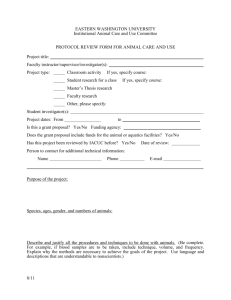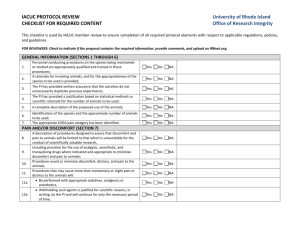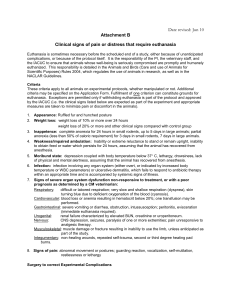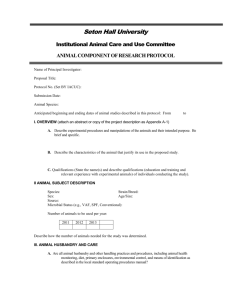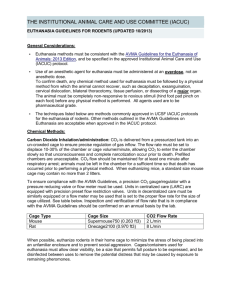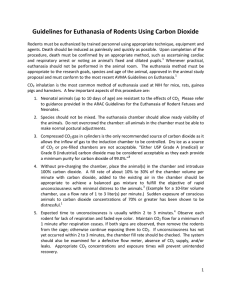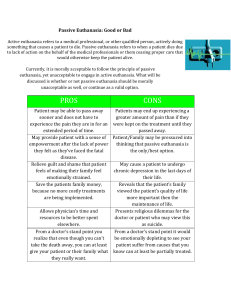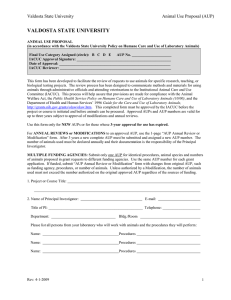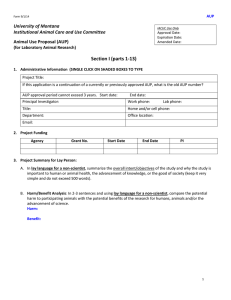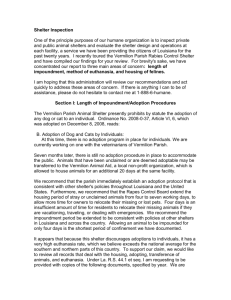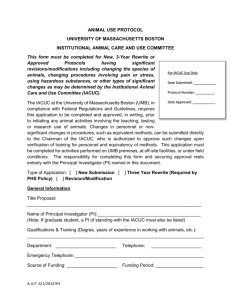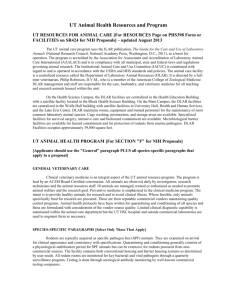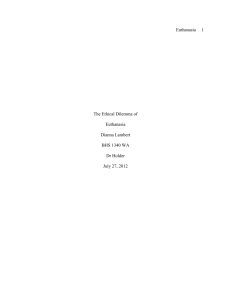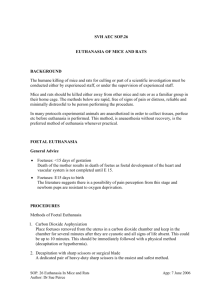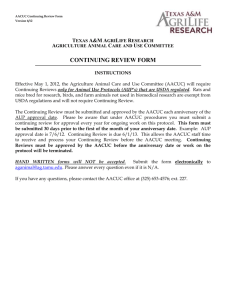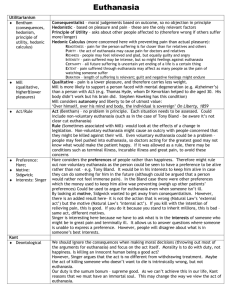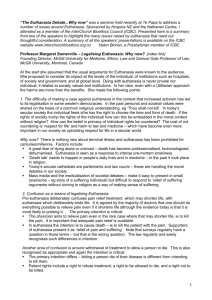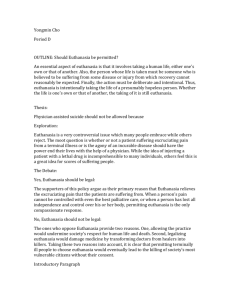Prevent or Minimize Delays in Protocol Approval
advertisement
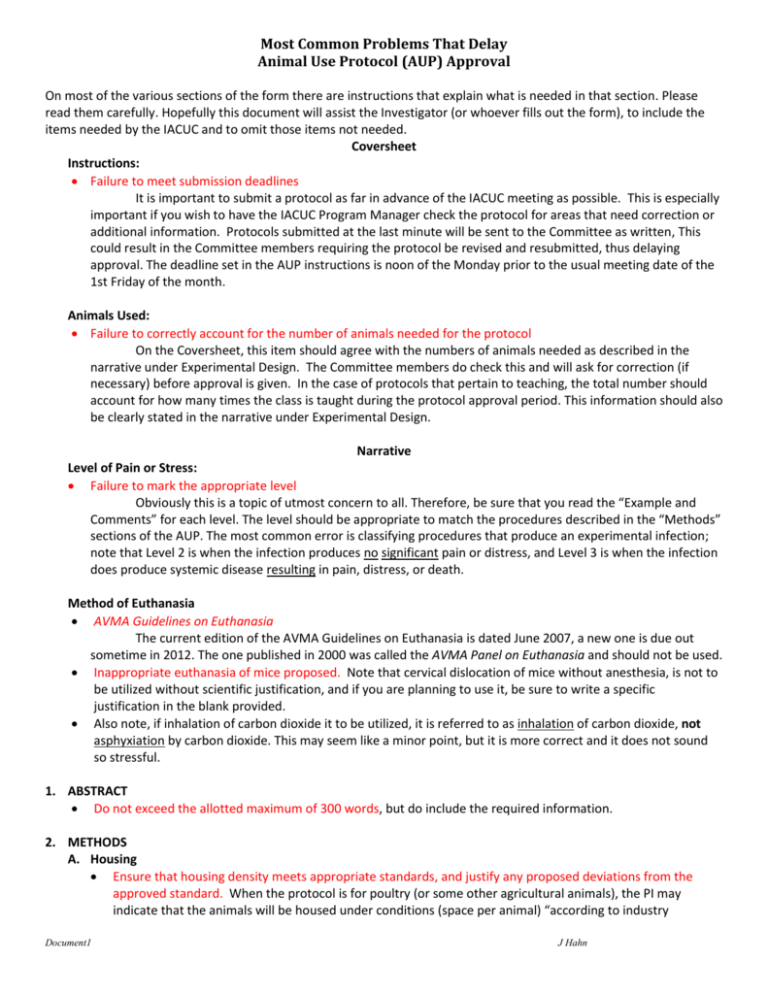
Most Common Problems That Delay Animal Use Protocol (AUP) Approval On most of the various sections of the form there are instructions that explain what is needed in that section. Please read them carefully. Hopefully this document will assist the Investigator (or whoever fills out the form), to include the items needed by the IACUC and to omit those items not needed. Coversheet Instructions: Failure to meet submission deadlines It is important to submit a protocol as far in advance of the IACUC meeting as possible. This is especially important if you wish to have the IACUC Program Manager check the protocol for areas that need correction or additional information. Protocols submitted at the last minute will be sent to the Committee as written, This could result in the Committee members requiring the protocol be revised and resubmitted, thus delaying approval. The deadline set in the AUP instructions is noon of the Monday prior to the usual meeting date of the 1st Friday of the month. Animals Used: Failure to correctly account for the number of animals needed for the protocol On the Coversheet, this item should agree with the numbers of animals needed as described in the narrative under Experimental Design. The Committee members do check this and will ask for correction (if necessary) before approval is given. In the case of protocols that pertain to teaching, the total number should account for how many times the class is taught during the protocol approval period. This information should also be clearly stated in the narrative under Experimental Design. Narrative Level of Pain or Stress: Failure to mark the appropriate level Obviously this is a topic of utmost concern to all. Therefore, be sure that you read the “Example and Comments” for each level. The level should be appropriate to match the procedures described in the “Methods” sections of the AUP. The most common error is classifying procedures that produce an experimental infection; note that Level 2 is when the infection produces no significant pain or distress, and Level 3 is when the infection does produce systemic disease resulting in pain, distress, or death. Method of Euthanasia AVMA Guidelines on Euthanasia The current edition of the AVMA Guidelines on Euthanasia is dated June 2007, a new one is due out sometime in 2012. The one published in 2000 was called the AVMA Panel on Euthanasia and should not be used. Inappropriate euthanasia of mice proposed. Note that cervical dislocation of mice without anesthesia, is not to be utilized without scientific justification, and if you are planning to use it, be sure to write a specific justification in the blank provided. Also note, if inhalation of carbon dioxide it to be utilized, it is referred to as inhalation of carbon dioxide, not asphyxiation by carbon dioxide. This may seem like a minor point, but it is more correct and it does not sound so stressful. 1. ABSTRACT Do not exceed the allotted maximum of 300 words, but do include the required information. 2. METHODS A. Housing Ensure that housing density meets appropriate standards, and justify any proposed deviations from the approved standard. When the protocol is for poultry (or some other agricultural animals), the PI may indicate that the animals will be housed under conditions (space per animal) “according to industry Document1 J Hahn Most Common Problems That Delay Animal Use Protocol (AUP) Approval standards.” Only in protocols that require commercial conditions is this acceptable. Otherwise the FASS Guide standards must be followed. B. Experimental design Ensure that the number of animals, groups, and treatments is clearly described. As noted in the instructions on the AUP Form, using tables listing groups with respective treatments and numbers of animals/group, etc. can be extremely useful in communicating your plan. It is a very real example of “a picture is worth a thousand words.” Provide sufficient detail for review by the committee. While many procedures are intuitively obvious to the investigator, they may not be so to all the Committee members. For example, in field research, banding birds implies a number of steps to the investigator and he/she may feel that stating that birds will be caught, banded and released is sufficient. However, the Committee requires more detail as to the procedures. Clearly state and describe terminal procedures. Indicate when procedures are terminal so that Committee members don't have to assume. C. Non-surgical procedures involving animals Describe all procedures involving the animals used. Be sure to indicate what sort of specimens are to be taken or harvested, and how it will be done. Also state what you will be testing and/or how you plan to evaluate the results of the purposed research. If planning to draw blood samples indicate how you will obtain the blood, how much will be obtained, and if it will be obtained on numerous occasions from the same animals, how often. Keep in mind that on the smaller animals there are limits that must be followed as to how much blood can be drawn at any one time, and how often it can be drawn. State level of training and experience and, where necessary, indicate how this will be achieved for research staff. If you plan to utilize some procedure or technique on the animals that you have no experience doing, explain how you plan to get trained or otherwise learn to learn the procedure or technique and be proficient at it. Remember the committee is very concerned about the animals being treated humanely. D. Surgical procedures Ensure that you have appropriate licensing for controlled substances used for anesthesia/analgesia. Appropriate anesthetic must be used, and most anesthetics are controlled drugs. It requires both a state and federal license to purchase, keep, and use controlled drugs. Also if post operative pain medication will be needed, more controlled drugs will be needed. These licenses take quite a bit of time to obtain. So plan appropriately. Clearly state the qualifications and skill level of those who will be performing surgical procedures. The surgeon needs to have appropriate qualifications and demonstrate the skill to perform the surgery planned. Clearly communicate the dosage of all drugs that are to be used. See the details in the instructions on the AUP Form. NOTE: The use of “expired” drugs is unallowable. E. Euthanasia Differentiate between euthanasia as part of the experimental design and euthanasia required due to illness or injury. Describe how you will monitor the animals to determine their health status. Again as stated before, if using carbon dioxide inhalation, use the term inhalation, not asphyxiation. Document1 J Hahn
